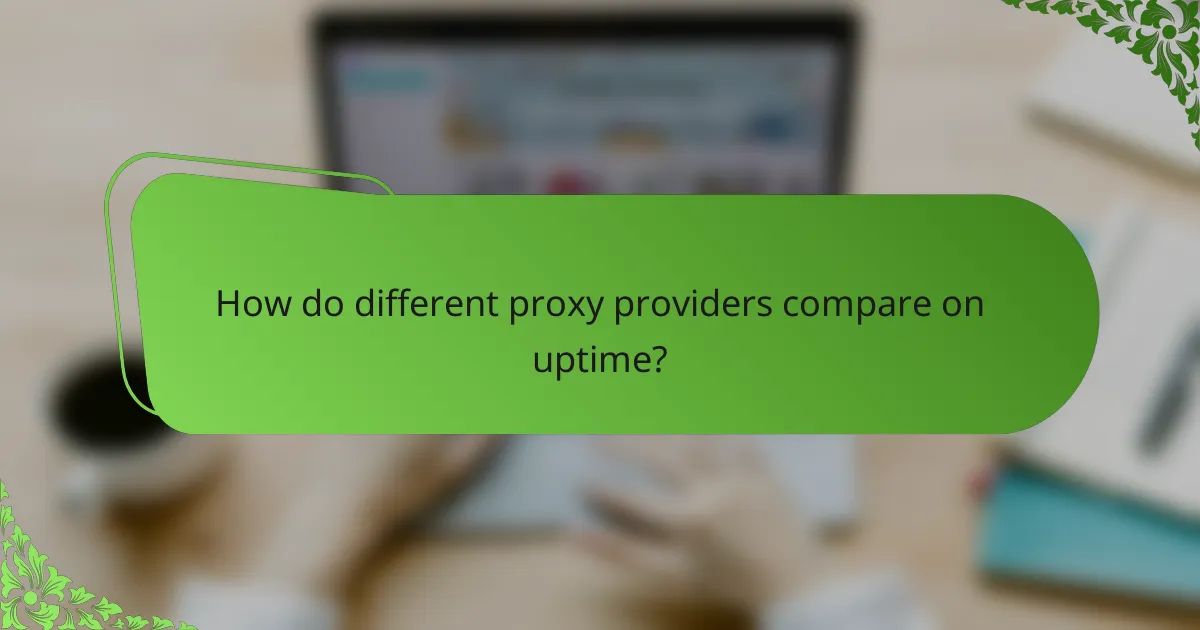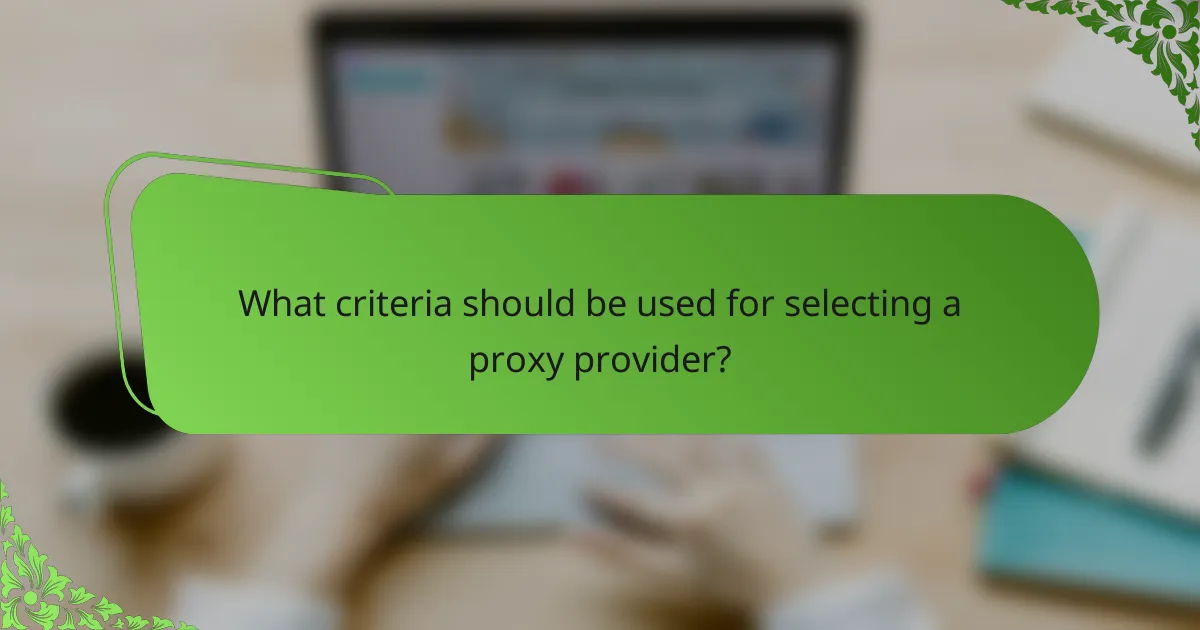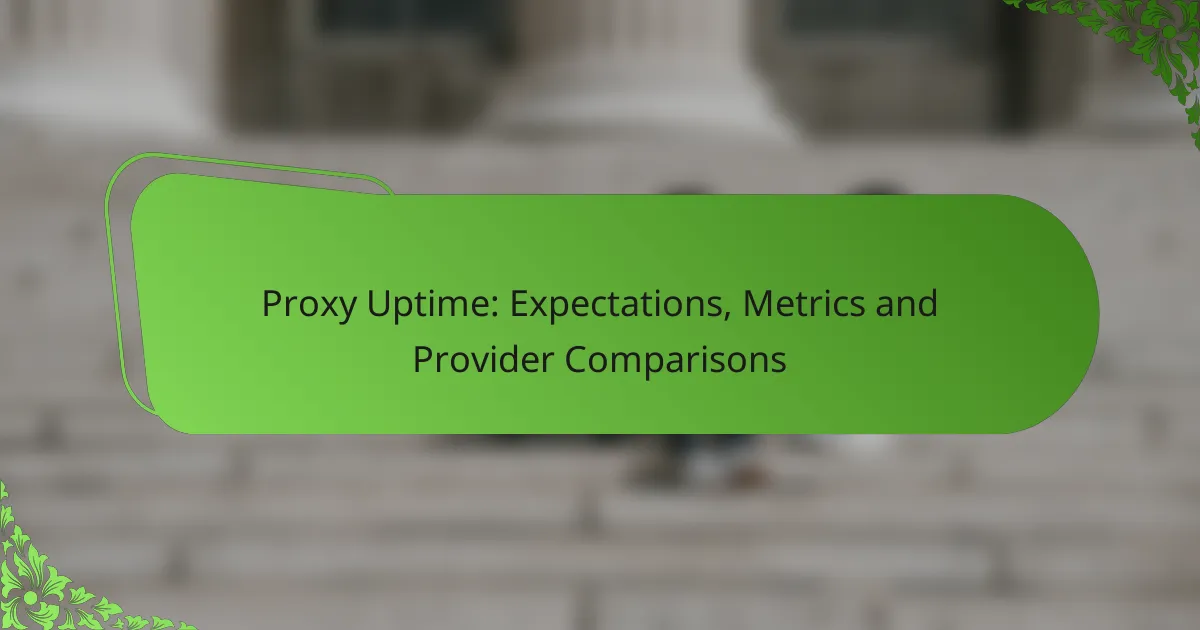In today’s digital landscape, reliable proxy uptime is essential for businesses seeking to maintain operational efficiency. Evaluating providers like Bright Data, Smartproxy, Oxylabs, and GeoSurf involves understanding key metrics such as uptime percentage, response times, and connection success rates. By focusing on these indicators, companies can make informed decisions to ensure optimal performance and minimal downtime.

What are the best proxy uptime solutions for businesses?
The best proxy uptime solutions for businesses focus on reliability, speed, and comprehensive monitoring features. Companies like Bright Data, Smartproxy, Oxylabs, and GeoSurf offer robust services that ensure minimal downtime and consistent performance, which are critical for maintaining operational efficiency.
Bright Data uptime monitoring
Bright Data provides advanced uptime monitoring tools that track the performance of proxies in real time. Their system alerts users to any downtime, allowing for quick adjustments to maintain service continuity.
With a reported uptime of over 99.9%, Bright Data is known for its reliability. Businesses can leverage their extensive network to ensure that they have access to proxies that are consistently operational.
Smartproxy uptime performance
Smartproxy boasts impressive uptime performance, typically exceeding 99.8%. Their infrastructure is designed to handle high traffic volumes while maintaining speed and reliability.
Users benefit from a user-friendly dashboard that provides insights into proxy performance and uptime statistics. This transparency helps businesses make informed decisions about their proxy usage and optimize their operations.
Oxylabs reliability metrics
Oxylabs is recognized for its strong reliability metrics, often achieving an uptime rate of around 99.9%. Their service includes proactive monitoring that helps identify issues before they impact users.
With a focus on enterprise-level solutions, Oxylabs offers dedicated support to troubleshoot any potential downtime issues, ensuring that businesses can rely on their proxies for critical tasks.
GeoSurf uptime statistics
GeoSurf reports a solid uptime performance of approximately 99.7%, making it a dependable choice for businesses needing consistent proxy access. Their services include detailed uptime statistics that help users track performance over time.
GeoSurf also emphasizes geographical diversity in its proxy offerings, which can enhance performance and reduce latency for users across different regions. This feature is particularly beneficial for businesses operating in multiple markets.

How to measure proxy uptime effectively?
Measuring proxy uptime effectively involves tracking key metrics that indicate the reliability and performance of your proxy service. Focus on uptime percentage, response times, and timely alerts to ensure optimal functionality and user experience.
Uptime percentage calculation
Uptime percentage is calculated by dividing the total operational time of the proxy by the total time it should have been operational, then multiplying by 100. For example, if a proxy is operational for 95 hours out of a 100-hour period, the uptime percentage would be 95%.
Monitoring tools can automate this calculation, providing real-time data on performance. Aim for an uptime percentage of at least 99% to ensure reliable service, as lower percentages can lead to significant disruptions.
Response time tracking
Response time tracking measures how quickly a proxy server responds to requests. This metric is crucial for assessing the efficiency of your proxy, with ideal response times generally in the low tens of milliseconds.
Utilize monitoring tools that log response times over various periods to identify trends. Consistently high response times may indicate server overload or network issues, necessitating further investigation or adjustments.
Downtime alerts and reporting
Implementing downtime alerts ensures you are immediately notified of any service interruptions. These alerts can be configured to send notifications via email or SMS when the proxy goes down, allowing for quick response and resolution.
Regular reporting on downtime incidents helps track patterns and identify recurring issues. Aim to review these reports monthly to assess overall performance and make informed decisions about your proxy service provider.

What metrics are crucial for proxy uptime assessment?
Key metrics for assessing proxy uptime include latency metrics, availability rates, and connection success rates. These indicators help determine the reliability and performance of proxy services, guiding users in selecting the best provider for their needs.
Latency metrics
Latency metrics measure the time it takes for a request to travel from the client to the proxy server and back. This is typically expressed in milliseconds (ms) and can significantly impact user experience, especially for real-time applications. Aim for latency in the low tens of ms for optimal performance.
When evaluating latency, consider factors such as geographic distance from the proxy server and network congestion. A proxy located closer to the user generally results in lower latency, enhancing speed and responsiveness.
Availability rates
Availability rates indicate the percentage of time a proxy service is operational and accessible. A high availability rate, ideally above 99%, is crucial for ensuring consistent access to resources. Downtime can lead to interruptions and lost opportunities, so choose providers with robust uptime guarantees.
To assess availability, monitor service status over time and check for any reported outages. Some providers offer real-time status dashboards, which can be a valuable resource for tracking performance.
Connection success rates
Connection success rates reflect the proportion of successful connections made through a proxy compared to total connection attempts. A high success rate, typically above 95%, indicates a reliable service that effectively handles requests without failures.
When evaluating connection success rates, consider the provider’s infrastructure and support for various protocols. Providers with redundant systems and strong technical support are more likely to maintain high success rates, ensuring smooth operation for users.

How do different proxy providers compare on uptime?
Proxy providers vary significantly in their uptime performance, which is crucial for ensuring reliable access to web resources. When comparing providers, consider metrics such as average uptime percentages, response times, and service reliability during peak usage hours.
Bright Data vs. Smartproxy
Bright Data typically offers higher uptime rates, often exceeding 99.9%, making it a strong choice for businesses that require consistent access. Smartproxy, while slightly lower in uptime, still maintains a solid performance around 99.8%, which is sufficient for many users.
When choosing between the two, consider the specific needs of your projects. Bright Data may be better for high-demand applications, while Smartproxy can be a cost-effective option for less critical tasks.
Oxylabs vs. GeoSurf
Oxylabs boasts impressive uptime metrics, often reported at around 99.9%, which is ideal for enterprises needing uninterrupted service. GeoSurf, on the other hand, maintains a respectable uptime of approximately 99.7%, making it a reliable alternative for various use cases.
In selecting between Oxylabs and GeoSurf, assess your budget and the critical nature of your operations. Oxylabs may come at a premium, but its reliability can justify the cost for mission-critical applications.
Comparative uptime analysis
When analyzing uptime across different providers, it’s essential to look at both historical data and real-time performance. Many providers publish their uptime statistics, which can help you gauge reliability over time.
Consider conducting your own tests or using third-party monitoring tools to verify claims. A good practice is to look for providers that offer service level agreements (SLAs) guaranteeing uptime, as this adds a layer of accountability.
Ultimately, the best choice will depend on your specific requirements, including budget constraints and the importance of uptime for your operations. Prioritize providers that align with your operational needs and offer transparent performance metrics.

What criteria should be used for selecting a proxy provider?
When selecting a proxy provider, focus on reliability, performance, and support. Key criteria include uptime guarantees, speed, geographic coverage, and customer service responsiveness.
Uptime guarantees
Uptime guarantees are critical when evaluating a proxy provider, as they indicate the expected reliability of the service. A good provider typically offers uptime guarantees of 99% or higher, meaning that the service should be operational almost all the time.
Consider the implications of uptime guarantees on your operations. For instance, if a provider claims 99.9% uptime, this translates to about 40 minutes of downtime per month. Compare these guarantees among providers to ensure you choose one that aligns with your operational needs.
Additionally, check if the provider offers compensation for downtime. Some may provide credits or refunds if they fail to meet their uptime commitments, which can be a valuable safety net for your business.










